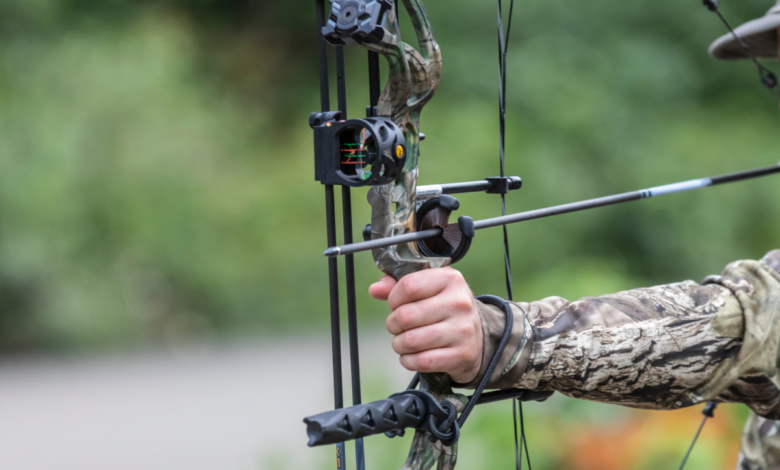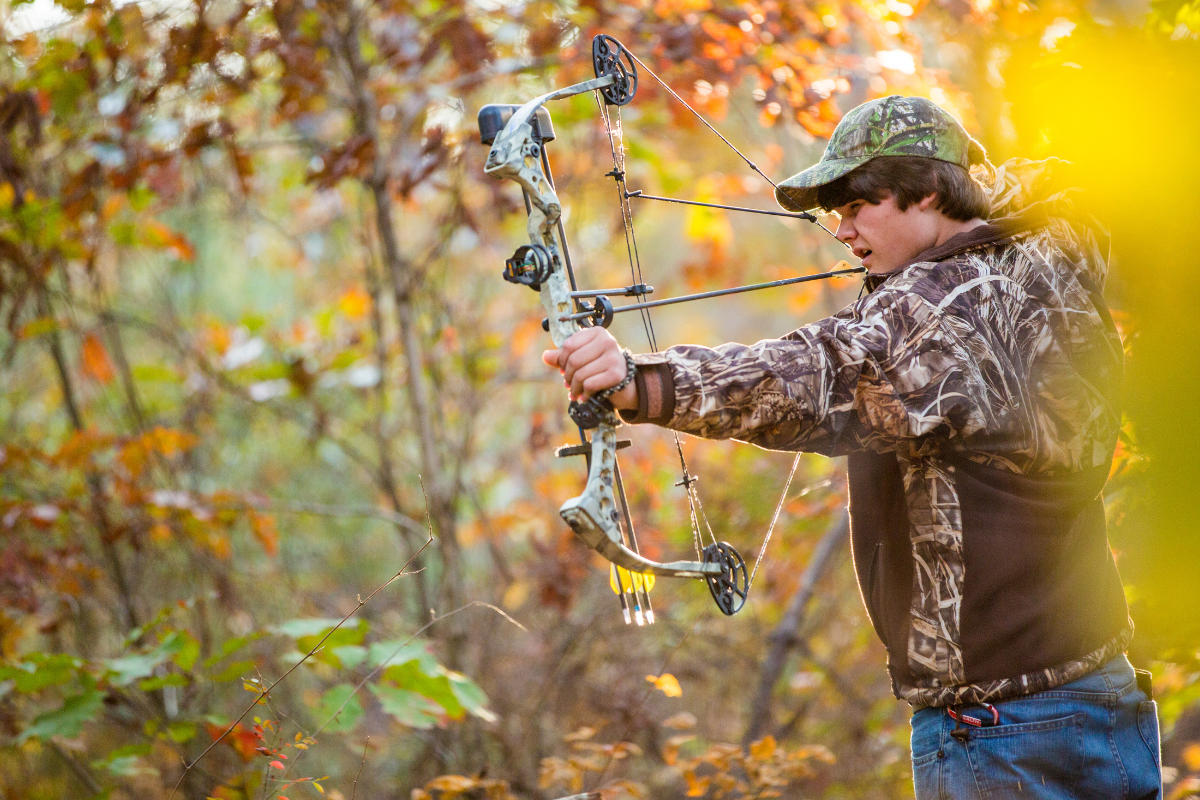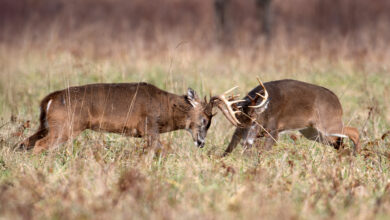Understanding The Basics for Bow Hunting Turkey

You know that the conventional choice of weapon for a turkey hunt is the old 12 gauge. But deep down, you might be looking for something to add to the challenge and get your heart pumping faster.
For that, turkey bow hunting is the perfect recipe.
Even with a shotgun, bringing the tom within range while beating its sharp vision is a tough task. With a bow, it gets tougher.
During my initial attempts with a bow, I missed almost every turkey in the woods and got busted a few times. But, when I tagged the first turkey it felt pretty sweet.
In this article, we will answer all your queries about bow hunting turkey.
Can You Bow Hunt Turkey? Why is it Such a Challenge?
Technically, bow hunting turkeys are the same as bowhunting whitetails. While you can use the same gear, you may need to pick up a few extras.
The only modification you can make is reducing the poundage. Waiting for the tom to come closer at full draw puts a lot of strain on the arm muscles. As a result, your accuracy can come down.
My preferred draw weight for turkey is 45 pounds. You can set it lower depending on your preferences.
I have seen hunters with the idea that shooting turkey with a bow is easier than shooting deer. They could not be more wrong.
If you ask me, the biggest challenge in shooting turkeys with a bow is keeping all that extra movement undetected. Know that the old tom has a watchful nature and eyes that are tuned to capture any suspicious movement. So, concealing the act of raising the bow and drawing requires the use of the best ground blinds.
Then you have the issue of fixing a target. A hit on the head and neck area is a gamble. Either you get a 100 percent clean kill or a clean miss.
Targeting the turkey body is a safer option, but visualizing the heart, lungs, or primary blood vessels in various positions can be challenging. I remember hitting a bird too low and it flew off never to be found again. Then again, your arrow might get deflected if it hits a thick wingbone.
All in all, you need to have a clear idea of where to shoot a turkey for hunting successfully with a bow. The best option is the front–on shot on the vitals of a strutting turkey.

The Importance of Turkey Calls for Bow Hunting Turkey
When you do not know the gobbler’s preferences, the ability to use several calls can be a great advantage. You may not sound like a real turkey, but even if you are a reasonably good caller, the chances of drawing the birds closer will go up.
Here is a fact about turkey hunting. When hunting pressure is high, the birds can fall silent. It is easy to fall into the trap of making more calls when the tom is call-shy. But a stubborn tom is experienced enough to recognize the “wrong” calls from the “right” ones. And overcalling will not be able to get his attention since it is not natural.
The best option is to act naturally and minimize the calling frequency. Making the gobbler curious enough to investigate requires patience. I have played hard-to-get a few times, even when the gobbler was within around 150-170 yards. In such scenarios, after waiting for a few minutes, I generate a few light yelps or putts to get the bird interested.
While bow hunting turkey in spring, it is important to read the body language of the tom and use the right call. If he is aggressive, a few cutts and yelps can pique his interest. If the tom is with a flock of hens, do not get over-aggressive. He may simply turn the flock away from your direction.
While using a shotgun, my strategy is to change locations every time I call. This makes it sound more natural. But, while bow hunting, you do not have that advantage. The best option is to be patient, minimize calling, and use the right combination of decoys.
Using Decoys
For bow hunters, turkey decoys are among the turkey hunting essentials as they serve a dual purpose. The first one is to attract the birds. For bow hunting, you want the bird to get as close to you as possible. The second is to distract the bird when it is within range, allowing you to make the draw.
The choice of decoy depends on the environment and the mood of the tom. Generally, with more decoys, there are more things for the tom to look at. For me, the combination of two hens and Jake decoy works well. Sometimes I place the male decoy over a lay down hen decoy.
However, multiple decoys do not ensure success in all environments. If it is early in the season, you can replace the jake with a full strut tom to make things look more aggressive. If it is late in the season, a single upright hen is a good option.
If you are a fan of running and gunning, bow-mounted decoys are worth a try. These are super-realistic decoys that are light enough to allow easy movement. These are best used in areas with bushes and other vegetation that can hide your profile.
It is also important to use yardage markers while placing decoys. I use natural markers to check if the bird is within the range of my longest shot.
Scouting Turkey Patterns
Pre-season or early-season scouting is effective as the foliage is yet to get dense and you can spot the birds from longer distances. Since a few flocks might still be together, the birds are easier to spot. Following turkey signs like droppings and strut marks wil give you an idea about their hunting grounds.
It is important to time your scouting trips right. Turkeys may change their movement patterns as the season changes to spring. Scouting two the three weeks before the season begins works best for me. Head out too early and you might end up looking in the wrong direction.
One of my favorite tactics is to find a vantage point, preferably at an elevation, during the evening. Then I listen to the gobbling toms which helps me to point out the roost locations.
Hunt the Season Phases Accordingly
Typically, the spring hunting season can be divided into three main phases based on turkey biology.
Early Phase
This is in very early spring when the winter turkey groups are breaking up. The males are under the influence of the breeding hormones, but the females are not ready to breed yet. Combining the strutting turkey decoy with a hen can be a good choice to make the toms aggressive.
If you can mark the travel pattern of the gobblers by scouting, you can set up the decoys in their path. Now, depending on your location, the best part of this phase may be over by the time the actual season begins. You might get some chances if the weather turns cold in late spring.
Middle Phase
This is the phase when the males have found their flock of hens and the amount of gobbling has come down. Since they are actively breeding, calling will not generate good results. Using the right decoys can help you attract some of the lonely males who were whipped by the boss gobblers.
The other option is roosting the birds as they tend to gobble at dawn. Once they are on the ground in the early morning, they are more likely to answer your calls.
Late Season
In the last phase, things get more exciting as the male turkeys get back to gobbling and start looking for new mates. The only difference is, they are not so aggressive anymore.
By this time, most of the hens are nesting. A few may have lost the nest to predators and looking for another session of breeding. Using lone hen decoys is the best option in this phase. Also, keep off from aggressive calling and focus on using mild yelps and putts.
When Bowhunting is Most Effective
When it comes to picking the best time of the day for archery turkey hunts, the choice is between early morning and midday. I am a big fan of early morning ambushes as I enjoy roosting. It also allows you to lure the gobbler away before the hens arrive. Plus, darkness provides an additional cover to set up your ambush.
If heading out in the woods at 3.30 am is no fun for you, try looking for flocks around midday. In many cases, I have found the toms to be more responsive to calls during this period.
I do not expect successful evening turkey hunting sessions with the bow. In many locations, the light levels come down too fast to make shooting effective.
Bow Hunting Turkey FAQs:
Can you bow hunt turkey without a blind?
Archery turkey hunting from a blind is the best option. However, some pro hunters use a combination of camo and natural covers like trees and bushes to hide their movements.
Where do you aim when bow hunting a turkey?
For a strutting turkey, a head-on shot works best. Aiming at a point, an inch above the beard, will give you a clean kill.
How far can you shoot a turkey with a bow?
For bow hunters, 15 to 20 yards is a good shooting distance to ensure a clean kill. If you are highly skilled with the bow, you can increase that to 25 yards.
Final Thoughts
Now, all that might make shooting turkey with a bow seem like a daunting task. Yes, it does require a lot of trial and error to find out what exactly works for you. And it does get maddeningly frustrating at times.
But honestly, once you master the art, it is incredibly rewarding!
When you achieve the required skill levels with hard work and patience, the feeling is unlike any other. Combining a bow and arrow along with woodsmanship- that is as close to classical turkey hunting as you can get.



